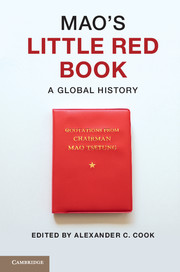Book contents
- Frontmatter
- Contents
- List of illustrations
- List of contributors
- Preface
- 1 Introduction
- 2 A single spark
- 3 Quotation songs
- 4 Mao quotations in factional battles and their afterlives
- 5 Translation and internationalism
- 6 Maoism in Tanzania
- 7 Empty symbol
- 8 The influence of Maoism in Peru
- 9 The book that bombed
- 10 Mao and the Albanians
- 11 Partisan legacies and anti-imperialist ambitions
- 12 Badge books and brand books
- 13 Principally contradiction
- 14 By the book
- 15 Conclusion
- Index
- References
Preface
Published online by Cambridge University Press: 05 June 2014
- Frontmatter
- Contents
- List of illustrations
- List of contributors
- Preface
- 1 Introduction
- 2 A single spark
- 3 Quotation songs
- 4 Mao quotations in factional battles and their afterlives
- 5 Translation and internationalism
- 6 Maoism in Tanzania
- 7 Empty symbol
- 8 The influence of Maoism in Peru
- 9 The book that bombed
- 10 Mao and the Albanians
- 11 Partisan legacies and anti-imperialist ambitions
- 12 Badge books and brand books
- 13 Principally contradiction
- 14 By the book
- 15 Conclusion
- Index
- References
Summary
Preface
The year 2014 marks the fiftieth anniversary of the publication of Quotations from Chairman Mao, commonly known outside China as the Little Red Book. At the height of its influence, the decade from the mid 1960s to the mid 1970s, this compact tome was the most printed book in the world. Official editions numbered well over a billion copies in three dozen languages, plus untold numbers of unofficial local reprints and unofficial translations in more than fifty languages. The book’s characteristic physical form – pocket-sized, bright red, clad in sturdy vinyl – reflected its practical origins as an ideological field manual for soldiers of the Chinese military, the People’s Liberation Army (PLA). The canonical revised edition that first appeared in 1965 arranged its 427 quotations into 33 thematic chapters, presenting extracts from Mao Zedong’s writings and speeches from 1929 to 1964, ranging in subject matter from philosophy to warfare to art. This easily digestible format drew upon two distinct literary genres: an ancient Chinese genre of collected wisdom dating back to the Analects of Confucius, and a modern genre of ideological primers embraced especially, but by no means exclusively, by Marxist–Leninists around the world. After Mao’s death, the book’s unsystematic presentation of fragments torn from their historical and textual contexts was widely dismissed as a vulgarization of Maoism (not to mention Marxism). During Mao’s lifetime, however, his quotations were adapted in China and elsewhere for many uses and in many forms – as a little red book, of course, but also as rhetoric, art, song, performance, accessory, symbol, talisman, badge, and weapon.
- Type
- Chapter
- Information
- Mao's Little Red BookA Global History, pp. xiii - xviPublisher: Cambridge University PressPrint publication year: 2014

